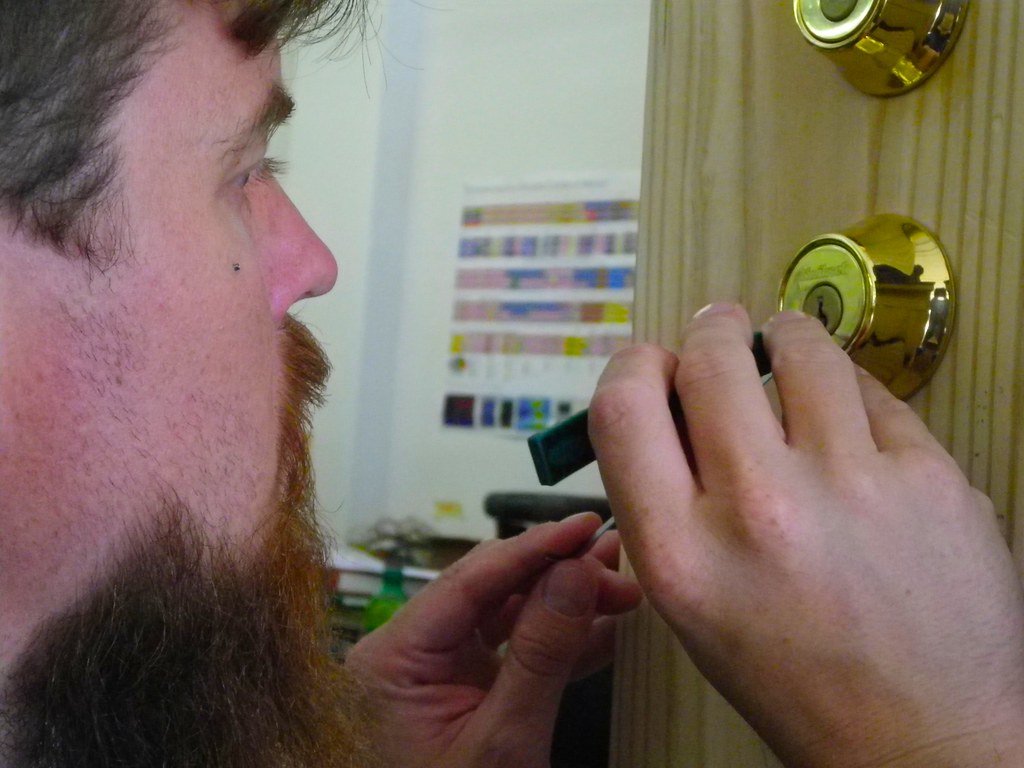Locked doors can be puzzling enigmas, quietly guarding secrets within their fortified frames. While some may find solace in the security they provide, locksmiths and lockpick enthusiasts see a challenge awaiting to be conquered. To these daring individuals, every locked door is an invitation to uncover the hidden mechanism that will grant them access. Yet, amidst the myriad of locks and an abundance of options, choosing the right tool for each lock can feel like navigating a labyrinth. Fear not, for in this guide, we will delve into the art of selecting the perfect pick for every lock, unraveling the mysteries that lie behind the tumblers and pins, and empowering you to master the craft of lockpicking with finesse and precision.
Table of Contents
- Mastering the Art of Lock Picking: Choosing the Perfect Pick for Every Lock
- Understanding Lock Mechanisms: Matching Picks to Lock Types
- Exploring Pick Materials and Design: Selecting the Optimal Tool
- Essential Factors to Consider: Thickness, Width, and Shape of Lock Picks
- Maximizing Success: Tips for Selecting the Right Pick Every Time
- Q&A
- To Conclude

Mastering the Art of Lock Picking: Choosing the Perfect Pick for Every Lock
Choosing the Perfect Pick for Every Lock
When it comes to mastering the art of lock picking, having the right tools is essential. Just as an artist selects the perfect brush or a sculptor chooses the ideal chisel, a proficient lock picker must carefully select the perfect pick for each lock they encounter. With countless options available, it can be overwhelming to determine which pick is best suited for a particular lock, but fear not – we’re here to guide you through the process.
First and foremost, it’s crucial to understand that not all locks are created equal. From standard pin tumbler locks to tubular locks and disc detainer locks, each type requires a specific approach. To choose the perfect pick, one must consider the lock’s complexity, design, and security measures. Lightweight, thin picks are ideal for simple pin tumbler locks, while sturdy, rigid picks are better suited for high-security locks that demand precision and strength.
Additionally, the shape of the pick plays a significant role in lock picking success. A hook pick, with its curved end, is versatile and works well for various types of locks. Meanwhile, a diamond pick is excellent for manipulating delicate components, and a rake pick can be a time-saving tool for locks with minimal security. Always remember to opt for high-quality picks, as they guarantee better durability and performance during your lock picking endeavors.
- Consider the lock’s complexity and security measures before selecting a pick.
- Choose lightweight and thin picks for simple pin tumbler locks.
- Opt for sturdy and rigid picks for high-security locks.
- Experiment with different pick shapes, such as hook, diamond, and rake picks.
- Invest in high-quality picks for better durability and performance.

Understanding Lock Mechanisms: Matching Picks to Lock Types
Lock Mechanisms: A Closer Look
Locks are intricate devices designed to secure valuables, premises, or information. They come in various types, each employing unique mechanisms to safeguard against unauthorized access. Understanding the differences between lock types and their corresponding picks is essential for any aspiring lockpicker or security enthusiast.
Pin Tumbler Locks:
- Pin tumbler locks are the most common and widely used type of lock.
- They consist of a series of pins that prevent the lock cylinder from turning without the correct key.
- These locks can be picked using a variety of tools, such as:
– Tension wrenches
– Single-pin picks
– Rake picks
– Diamond picks
Wafer Locks:
- Wafer locks utilize flat wafers as their main security components.
- These locks can be found in various items like filing cabinets and car doors.
- Wafer locks require specific picks, such as:
– Wafer picks
– Jiggler keys
– Inflatable wedges
Tubular Locks:
- Tubular locks are characterized by their cylindrical shape with several pins arranged in a circular pattern.
- These locks are commonly found in vending machines and bicycle locks.
- Picking tubular locks requires specialized tools including:
– Tubular lock picks
– Tubular lock tension wrenches
By understanding the mechanisms behind various lock types, you can better match the appropriate picks and tools to effectively manipulate or secure locks. Remember, always practice lockpicking responsibly and adhere to local laws and ethical guidelines.

Exploring Pick Materials and Design: Selecting the Optimal Tool
When it comes to selecting the optimal tool for your needs, exploring pick materials and design is essential. The right choice can greatly impact the efficiency and effectiveness of your work. Here are some factors to consider:
- Material Durability: The durability of the pick material plays a crucial role in its performance. For heavy-duty tasks, consider high-carbon steel picks that offer excellent strength and resistance to wear and tear. For more delicate projects, non-sparking materials like brass or copper can be a safer choice.
- Ergonomic Design: Don’t overlook the importance of ergonomics. Comfortable grips and handles ensure a secure hold, minimizing fatigue and increasing precision during prolonged use. Look for features like cushioned grips or rubber coatings that provide a non-slip hold, reducing the risk of accidents.
- Specialized Pick Types: Consider the specific needs of your task and select the pick design accordingly. Some common types include point picks, chisel picks, and offset picks. Each type offers unique advantages for different applications, so understanding their features is crucial in making the right choice.
By carefully exploring the various pick materials and designs available, you can confidently select the optimal tool that meets your requirements. Remember to consider factors such as material durability, ergonomic design, and specialized pick types. Investing time in research now will undoubtedly pay off in smoother and more efficient work down the line.
Essential Factors to Consider: Thickness, Width, and Shape of Lock Picks
Lock picking is an art that requires skill and precision. When it comes to choosing the right tools for this delicate task, there are several critical factors to consider. The thickness of a lock pick plays a significant role in its effectiveness. Thicker picks provide stability and strength, allowing you to exert the necessary pressure without fear of breaking. On the other hand, thinner picks offer more flexibility, enabling you to navigate complex lock mechanisms with ease.
Width is another crucial consideration when selecting lock picks. A wider pick can cover a larger area within the lock, increasing the chances of finding the correct pin positioning. Conversely, narrower picks allow for greater precision in individual pin manipulation, making them ideal for intricate locks. It’s important to strike a balance between width and functionality to ensure success in a variety of lock picking scenarios.
The shape of a lock pick can greatly influence your ability to maneuver within a lock. Hooks, diamonds, and rake-shaped picks all serve different purposes. Hooks are ideal for single-pin picking, providing a precise means of manipulating a pin at a time. Meanwhile, diamond-shaped picks are excellent for raking, which involves rapidly bumping multiple pins to set them simultaneously. Rake picks save time and are particularly useful for low-security locks. Ultimately, the shape of your lock pick should align with your preferred lock picking technique and the level of security you are dealing with.
In conclusion, thickness, width, and shape are vital considerations when choosing lock picks. They directly impact your ability to effectively manipulate pin tumblers and successfully unlock a myriad of locks. By understanding these factors and selecting the right tools for the job, you’ll enhance your lock picking skills and increase your chances of overcoming even the most complex locking mechanisms.
Maximizing Success: Tips for Selecting the Right Pick Every Time
In the world of decision-making, choosing the right option can make all the difference in achieving success. Whether it’s picking the perfect stock for your investment portfolio or selecting a winning team for a project, here are some valuable tips to help you consistently make the best choices:
- Define your criteria: Before making any decision, clearly identify your goals and criteria. What specific outcomes are you looking to achieve? By establishing these parameters, you can narrow down your options and focus on what truly matters.
- Research and gather information: Take the time to gather as much relevant information as you can about the options available to you. Conduct thorough research, seek expert opinions, and consider past experiences to make an informed decision.
- Weigh the pros and cons: Create a list of pros and cons for each option. This simple exercise can help you visualize the potential benefits and drawbacks of each choice. By comparing and contrasting, you can gain clarity and identify the option that aligns best with your goals.
- Trust your instincts: While data and analysis are vital, don’t underestimate the power of intuition. Your gut feeling can often guide you in the right direction. If all the logical aspects align but something doesn’t feel right, it might be worth exploring alternative options.
- Learn from past decisions: Reflecting on previous decisions can provide valuable insights into your decision-making patterns. Analyze both successful and unsuccessful choices to identify any recurring mistakes or strategies that led to positive outcomes. Continually refining your decision-making process will increase your chances of selecting the right pick every time.
Remember, making the right pick every time requires a combination of analytical thinking, intuition, and a willingness to learn from experience. By following these tips, you can improve your decision-making skills and maximize your chances of achieving success.
Q&A
Q: What tools do I need to pick a lock?
A: To pick a lock, you will need a set of lock picks, including a tension wrench and a variety of picks such as hook, diamond, and rake. Additionally, a small flashlight can be useful for better visibility.
Q: How do I determine the right pick for a specific lock?
A: The right pick depends on the type of lock and your level of expertise. Generally, a hook pick is suitable for single-pin picking, while a rake pick is more effective for quick opening of pin-tumbler locks. Experimentation and practice will help you find the best pick for each lock.
Q: Are there different picks for different types of locks?
A: Yes, there are various picks designed to cater to different lock types. For padlocks, a diamond pick is often recommended, while tubular locks may require a specialized tubular lock pick. It’s crucial to have a diverse pick set to meet the needs of various lock mechanisms.
Q: What should I consider when choosing the right tension wrench?
A: Selecting the right tension wrench is essential for successful lock picking. Factors to consider include the type of lock, size of the keyway, and personal preference. It’s advisable to have a variety of wrenches to ensure a snug fit and proper tension during the picking process.
Q: Can I use any pick for any lock?
A: While some picks may work on multiple locks, it is recommended to match the characteristics of the lock with the appropriate pick to increase your chances of success. Different lock designs may require specific picks that are better suited for their mechanisms.
Q: Is it legal to pick locks as a hobby?
A: The legality of lock picking as a hobby varies from country to country. In some places, it is legal as long as you only pick locks you own or have explicit permission to practice on. However, it is important to familiarize yourself with local laws and regulations before engaging in lock picking as a hobby.
Q: How long does it take to learn lock picking?
A: Lock picking is a skill that requires practice and patience. The time it takes to become proficient varies depending on the complexity of the locks and your dedication to learning. With regular practice, one can expect to develop fundamental skills within a few weeks or months.
Q: What are some resources to learn lock picking?
A: There are various resources available, such as online tutorials, books, and lock picking forums, that can help you learn the art of lock picking. Consider joining local lock picking clubs or attending workshops to gain hands-on experience and guidance from experienced lock pickers.
To Conclude
In the intricate world of locks and keys, there lies an art that goes beyond the conventional objectives of security and access. It’s an art that requires finesse, knowledge, and a touch of the extraordinary. From the seductive click that resonates through the darkness to the palpable thrill of a successful pick, the journey of a lockpicker is never mundane.
As we bid adieu to our adventure on how to choose the right pick for every lock, we hope you have emerged enlightened and inspired. So often, we neglect the beauty that lies hidden within the mundane objects of our everyday lives. But a lock, dear reader, is not just a mere mechanism to be conquered. It is an exquisite blend of engineering brilliance and subtle intricacies that beckons us to embark on a journey of understanding.
Whether you’re an aspiring lockpicker or simply an enthusiast seeking insight, remember that choosing the right pick is an intimate dance between magic and science. It’s an exploration of not only the lock’s design but also its soul, as if connecting with a long-lost companion. Each lock has its own story, its unique vulnerabilities waiting to be discovered.
Take a moment to marvel at the array of picks before you, each possessing its own charm and allure. Like a symphony orchestra, they come together to create harmonious melodies that unlock the secrets of the world. From the elegant hook to the nimble diamond, each pick has a purpose, a role to play in the grand performance of lock manipulation.
But with great power comes great responsibility. As you delve deeper into the realm of picking, remember to respect the art, the craft, and the trust placed upon you. For within each lock, there lies the hopes and dreams of countless souls who rely on the sanctity it provides.
So, dear reader, armed with newfound knowledge and a heart filled with wonder, go forth and embrace this peculiar art. Remember, it’s not just about choosing the right pick for every lock; it’s about plunging into the depths of the keys and understanding the intricate dance they share.
As an affiliate, my content may feature links to products I personally use and recommend. By taking action, like subscribing or making a purchase, you’ll be supporting my work and fueling my taco cravings at the same time. Win-win, right?
Want to read more? Check out our Affiliate Disclosure page.